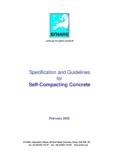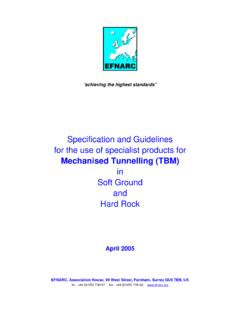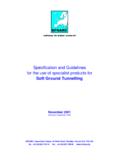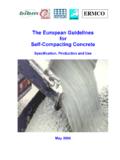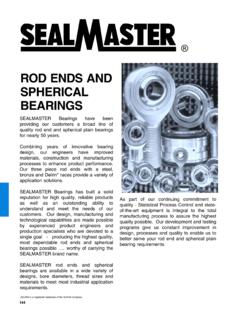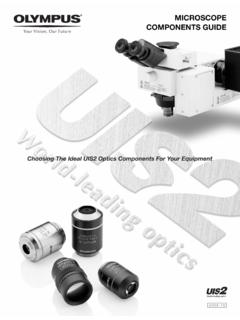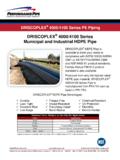Transcription of SPECIFICATION & GUIDELINES FOR POLYMER …
1 1""" achieving the highest standards"achieving the highest standards"achieving the highest standards" SPECIFICATION & GUIDELINESFORPOLYMER- modified cementitious FLOORINGas wearing surfacesfor industrial and commercial useEFNARC, Association House, 99 West Street, Farnham, Surrey, GU9 7EN, UKtel: +44 (0)1252 739147 fax: +44 (0)1252 739140 was founded in March 1989 by five national trade associations representing producers andapplicators of specialist construction products. Membership has since been widened to include majorEuropean companies who have no national body or institution to represent their interests. EFNARC provides a common voice for the industry to make known its comments and views to the EuropeanCommission, CEN Technical Committees and other groups dealing with European Harmonisation ofSpecification and Standards.
2 Its Members are active in all European has achieved a fine international reputation for its excellent work in preparing authoritativeSpecifications and GUIDELINES firstly for Sprayed Concrete and then for Industrial Flooring. Thesespecifications have become recognised as essential reference documents by specifiers, contractorsand material suppliers throughout Europe and beyond, and have formed the basis for new nationalproduct EFNARC ' SPECIFICATION for Synthetic Resin and POLYMER - modified cementitious Flooringsfor Industrial Use' was published in November 1997 as a draft for public comment. Since that timemany copies of the draft version have been issued and it has also been registered as a formaldocument by the CEN committee (TC 303) responsible for European standards for flooring.
3 Asrequested, many users have submitted comments and these have been taken into account in theproduction of this definitive SPECIFICATION . A major change from the draft stage is that separatespecifications have now been produced for POLYMER - modified cementitious and Synthetic ResinFloorings respectively. This recognises that the two types of specialist floorings generally havedifferent end significant change is the removal of requirements for Identification tests. The requirementthat manufacturers should operate a formal independently-certified quality control scheme will give thecustomer assurance of continuity of formulation. Also it is believed that the performance requirementsare a better check that the product will give satisfactory service than a series of analytical tests thatmay not in themselves be wishes to acknowledge gratefully all the contributions and comments made by users of thedraft Flooring SPECIFICATION published in 1997 and to the subsequent extensive work undertaken bymembers of its Flooring Technical care has been taken to ensure, to the best of our knowledge that all data and information contained herein is accurateto the extent that it relates to either matters of fact or accepted practice or matters of opinion at the time of publication.
4 EFNARC assumes no responsibility for any errors in or misrepresentation of such data and/or information or any loss ordamage arising from or related to its rights reserved. No part of this publication may be reproduced, stored in a retrieval system or transmitted, in any form or byany means, electronic, mechanical, recording or otherwise, without prior permission of 0 9539733 6 0 EFNARC 2001 EFNARC: SPECIFICATION and GUIDELINES for POLYMER - modified cementitious Flooring31 INTRODUCTIONThis SPECIFICATION provides minimum standards of performance and methods of installation forPolymer- modified cementitious (PCC) floorings intended to form a wearing surface. These flooringsare based on POLYMER - modified cementitious systems that cure by hydration of the hydraulic cementcomponent with the added POLYMER enhancing the properties of the set wearing surfaces can give satisfactory service under many industrial conditions but becomeless effective where there are specific requirements of hygiene, cleanliness, chemical resistance,resistance to impact or abrasion.
5 The main advantages of PCC floorings when compared withunmodified concrete wearing surfaces include the following:a]stronger permanent bond to the substrateb]improved resistance to some aggressive chemicalsc]increased resistance to absorption of liquids and greasesd]increased toughness, durability, resilience, and resistance to impact or abrasione]reduced dustingf]more hygienic, easily cleaned surfacesg]greater resistance to crackingh]lower applied thickness2 SCOPEThis SPECIFICATION covers the performance, design and installation of flow-applied or trowel-finishedPolymer- modified cementitious floorings (PCC), to be applied in situ as a wearing surface to a directfinished concrete base or fine concrete floorings modified with reactive resins are not included although many of therequirements in this document may be relevant to STANDARDSThe following standards are referred to in the SPECIFICATION .
6 However, any subsequently published orrevised European Standard (EN) should always take preference over standards referred to hierarchy of authority is EN standard, ISO standard, National 1008 Mixing water for concreteEN 1542 Products and systems for the protection and repair of concretestructures - Test methods - Measurement of bond strength by pull-offEN 1766 Reference concretes for testingEN 12086 Permeability to water vapourEN 12504-2 Testing concrete in structures: Determination of rebound numberEN 13036-4 Test method for skid resistanceEN 13454-2 Method of test for screed materials - Determination of consistencyEN 13892:Methods of test for screed materials EN 13892-2 Determination of flexural and compressive strength EN 13892-4 Determination of wear resistance BCA EN 13892-5 Determination of wear resistance to rolling wheel EN 13892-8 Determination of bond strengthISO 178 Determination of elastic modulus in flexureEN ISO 6272 Determination of impact resistanceBS 8204:In situ floorings: BS 8204-1 Code of practice for concrete bases and screeds to receive in situ floorings BS 8204-2 Code of practice for concrete wearing surfacesNote:Some of these standards may be in preparation and only available as prEN.
7 SPECIFICATION and GUIDELINES for POLYMER - modified cementitious added in small quantity during a mixing process to modify the properties of a cementitiousscreed material in the fresh and/or hardened dispersed insoluble solid material that provides colour and opacity to the flooring products or Bonding agentA liquid product applied to a substrate, either subfloor or base, prior to the application of the finalflooring, to seal and consolidate the surface of a porous substrate and aid adhesion of the resinA reactive organic POLYMER binder for a flooring system comprising one or more components that reactat ambient compoundProduct applied to a newly laid concrete surface to reduce loss of moisture by materialMaterial placed within a floor structure to provide either acoustic and/or thermal , wires, meshes or fibres added to element which provides the support for a screed and any other flooring of material or materials laid in situ, directly onto a base, bonded or unbonded, or onto anintermediate layer or insulation layer.
8 To achieve one or more of the following obtain a defined carry the final provide a wearing layer of a floor that is designed to provide a wearing surface: this layer may consist of aproduct or system of of screed or flooring bounded by joints or free recess in the floor surface designed to collect liquid flowing over the surface and direct itto the joint/ Construction jointJoint incorporated where work is interrupted either by design or accident so that subsequent work willprovide discontinuity in the : SPECIFICATION and GUIDELINES for POLYMER - modified cementitious discontinuity in either the whole or a part of the thickness of a screed or other jointJoint between building elements or screed bays which can absorb dimensional changes isolating jointIsolating strip placed between a screed and vertical elements of the SkirtingContinuation of the floor surface up the lower part of a vertical wall, kerb or plinth.
9 Generally Wearing surfaceUpper surface of a screed designed to be used as a final CoreCylindrical specimen cut from a hardened screedScreed which is bonded to the screedScreed where the binder is a hydraulic membraneLayer or layers in a floor to resist the passage of screedHighly fluid screed composition with self-smoothing (or self-levelling) screedScreed applied to compensate for unevenness in the base or to accommodate pipes or provide adefined screedCementitious screed laid onto the still plastic surface of a fresh concrete cementitious screed (PCC - POLYMER cement concrete)Screed where the binder is a hydraulic cement and which is modified by the addition of polymerdispersion or re-dispersible powder POLYMER with a minimum content of dry POLYMER of 1% by mass ofthe total composition, excluding aggregate particles larger than 5 screedScreed containing SealerA liquid product applied to the surface of a flooring product to seal any porosity and generally toenhance the chemical resistance, aesthetic appearance and/or reduce dusting of the Synthetic resin flooringMixture of synthetic resin, aggregates and pigments that hardens on curing by means of chemicalreaction but excluding oxidative drying.
10 (PC - POLYMER concrete) Synthetic resin screedScreed where the binder consists of synthetic : SPECIFICATION and GUIDELINES for POLYMER - modified cementitious Synthetic resin coatingFluid synthetic resin based composition that can be applied as a thin layer to a concrete or othersubstrate, which then sets to provide a coherent wearing lifeThe time following mixing during which the flooring material can be applied and finished withoutdetrimental effect on its properties such as adhesion, compaction and surface resistanceResistance to wear by mechanical action of a flooring resistanceThe capacity of the flooring surface to withstand exposure to chemicals without significant change toits service measure of fluidity of fresh screed or flooring material that characterises its ease of of irregularly shaped micro-cracks formed on the surface of a resistivityA measure of the ability of the flooring system to conduct testProcedure to characterise a product in order to check its compliance with a reference sample batchused for initial type testing or customer acceptance of the surface of a flooring layer to a fixed datum plane within allowable of a flooring product or system to provide a durable floor with effective service


